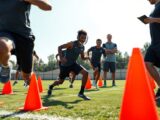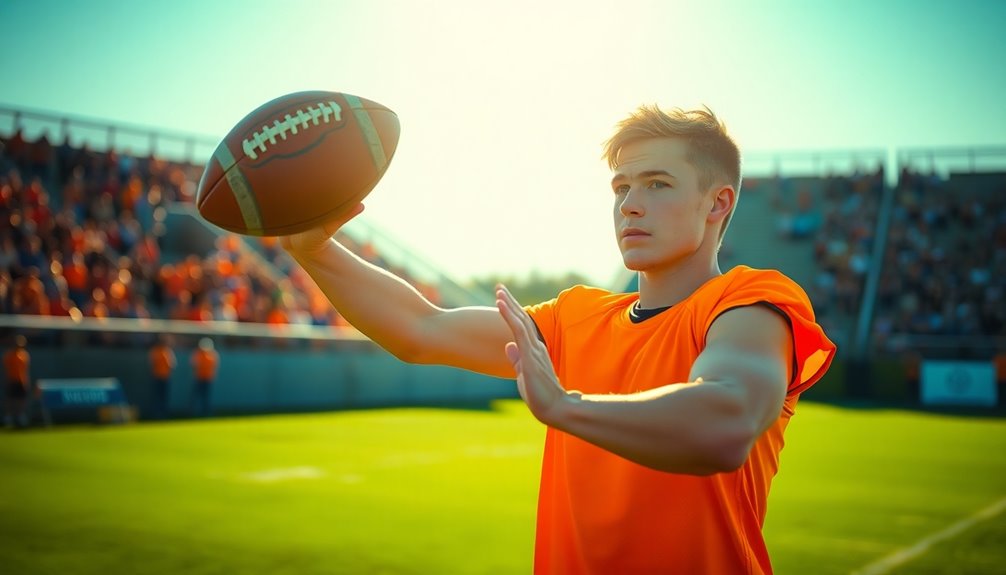
How to Properly Throw a Football With Confidence
January 18, 2025To throw a football with confidence, start by mastering your technique. Stand with your feet shoulder-width apart and knees slightly bent for a stable base. Grip the ball securely, with fingers on the laces and your thumb underneath. As you throw, rotate your shoulders back, keep your elbow above your waist, and snap your wrist at the peak of your motion for a tight spiral. Don't underestimate the power of mental preparation—visualize your success and practice positive self-talk. Engaging in specific drills will also boost your skills and confidence. There's plenty more to uncover to enhance your performance.
Importance of Throwing Technique
Throwing technique is the backbone of effective football gameplay. When you master your throwing motion, it not only enhances your throwing power but also boosts your accuracy and consistency. This mastery is essential for executing precise passes that can change the outcome of a game. Additionally, developing your core strength can significantly improve your stability and power during throws. Incorporating strength training into your routine can further enhance your overall throwing performance.
By focusing on proper throwing mechanics, you can generate power from your legs and trunk, ensuring a smooth, controlled release of the ball.
Common mistakes like poor stance or neglecting follow-through can seriously undermine your performance. If you want to succeed, you've got to avoid these pitfalls and embrace proper technique.
Incorporating specific drills, such as target practice and partner passing, can also help refine your skills. These exercises allow you to develop better timing and rhythm, making your throws more effective during gameplay. Additionally, understanding the evolution of equipment can provide insights into how advancements in gear can enhance overall performance on the field.
Proper Hand Placement
Mastering proper hand placement is vital for anyone looking to throw a football with confidence. A secure grip can greatly enhance your throwing ability, so focus on how you hold the ball.
Here are a few key points to take into account:
- Grip the football securely with your fingers on the laces and your thumb underneath for stability. Aim for 2-4 fingers on the laces based on your comfort level.
- Position the ball near your ear during the throwing motion. This helps with targeting and control.
- Keep a slight gap between your hand and the ball. This allows for a more natural release and reduces the chances of a tight grip, which can negatively affect spin.
- Experiment with different grip styles during practice. Discover what feels most comfortable and effective for your throwing technique.
- Remember that proper hand placement is vital for achieving a spiral throw, as it influences the ball's stability, spin, and trajectory. Additionally, maintaining a strong mental resilience during practice can significantly improve your confidence and overall performance in throwing. Understanding the importance of field dimensions can also help you gauge your throwing distance better. Practicing regularly also enhances your technical abilities, ensuring that your throwing skills are sharp and effective.
Basic Throwing Techniques
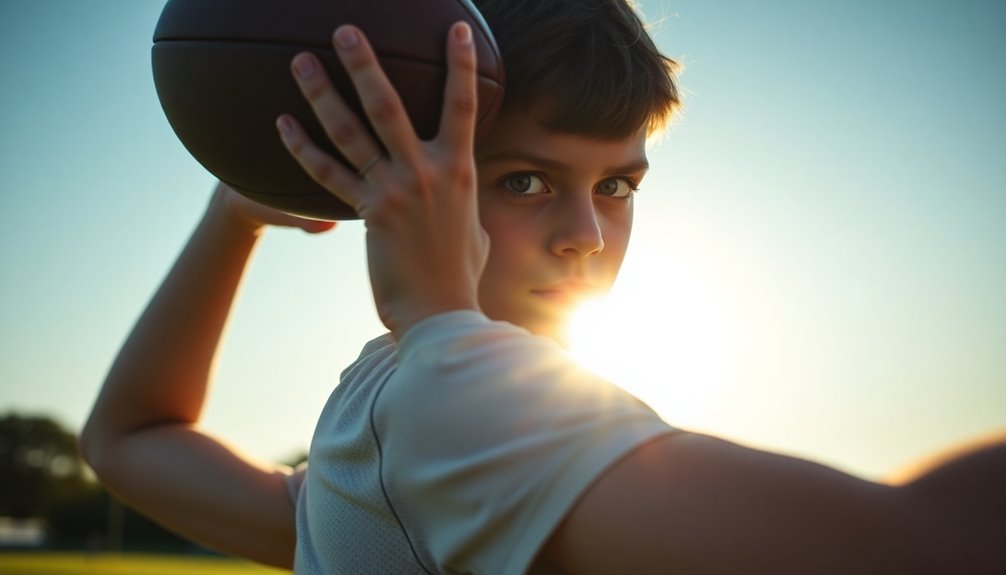
Having a solid grip on the football sets the stage for effective throwing techniques. Start by placing your fingers on the laces and your thumb underneath for stability. This grip and control not only enhance your accuracy but also make it easier to throw the football with confidence. Understanding basic rules of throwing mechanics can further improve your technique. Additionally, mastering close ball control techniques can help develop better coordination between your hands and feet.
Next, position your feet shoulder-width apart with your knees slightly bent, establishing a balanced stance that's essential for weight transfer. As you wind up, rotate your shoulders back, keeping your elbow above your waist to prepare for a powerful release.
When it's time to throw, snap your wrist at the peak of your motion. This action creates the necessary spin for a tight spiral, boosting your throw's accuracy. Practicing consistent passing accuracy enhances your overall throwing performance and builds confidence in your technique.
Throwing Motion Fundamentals
To achieve an effective throwing motion, start by ensuring your stance is stable and balanced. Position your feet shoulder-width apart with your knees slightly bent. This foundation provides the power and balance needed for a successful throw. Additionally, maintaining proper spacing is essential for executing accurate throws under pressure. Regular consistent practice will also help reinforce these fundamentals over time.
As you prepare to throw, rotate your shoulders back while keeping your elbow above your waist. This technique generates torque and sets you up for accuracy.
When you're ready to release the ball, remember to snap your wrist to create a tight spiral. This action enhances the ball's stability and distance.
Here are the key fundamentals to keep in mind:
- Feet shoulder-width apart, knees bent
- Rotate shoulders back, elbow above waist
- Snap your wrist when you release the ball
- Step with your opposite foot toward the target
- Follow through by extending your arm and finishing high. Additionally, practicing teamwork in sports can improve your overall confidence in executing skills like throwing.
Essential Drills for Improvement
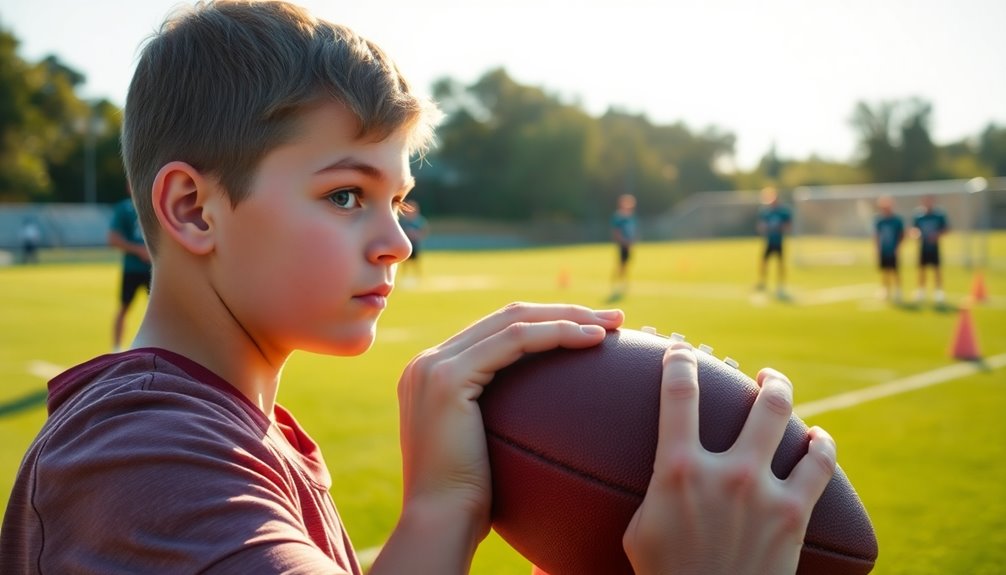
To improve your throwing skills, you should focus on target practice techniques, partner passing drills, and footwork agility exercises. Each of these drills hones specific aspects of your game, from accuracy to balance. Incorporating them into your routine will help you build confidence and become a more effective quarterback. Additionally, incorporating cardio training will enhance your overall performance by improving your stamina and endurance on the field. To further boost your agility, consider including agility training which can enhance movement and reaction time, making you quicker on the field. Incorporating speed and agility drills into your training regimen can further elevate your performance under pressure during games.
Target Practice Techniques
Practicing target drills is essential for improving your football throwing skills and building confidence. By focusing on precision and varying your approach, you'll enhance your ability to throw the football accurately at different distances.
Here are some effective techniques to incorporate into your practice routine:
- Target Practice Drill: Set up multiple targets at varying distances to improve accuracy and gauge your throwing strength.
- Moving Target Practice: Use a teammate as a moving target to simulate game conditions, helping you improve your throw timing and accuracy under pressure.
- Target Size Variation: Challenge yourself with targets of different sizes, such as hula hoops or cones, to enhance your adaptability in throwing.
- Progressive Distance Challenge: Begin your practice close and gradually increase the throwing distance, ensuring you maintain form and accuracy as you extend your range.
- Feedback Mechanism: Record your throws and analyze them, or have a coach provide feedback on your mechanics, helping you identify areas for improvement.
Incorporating these drills won't only boost your confidence but also greatly enhance your performance when throwing the football.
Partner Passing Drills
Partner passing drills are a fantastic way to improve your throwing and catching skills while building a strong connection with your teammate. Start by standing just a few yards apart, focusing on short, accurate throws. This helps you develop timing and rhythm, allowing you to understand each other's throwing and catching styles better.
As you gain confidence, gradually increase the distance between you to enhance your accuracy over longer throws.
Incorporate variations into your partner passing drills, such as quick releases and different throwing angles. This not only helps you adapt to various game situations but also sharpens your throwing mechanics.
Remember, consistent practice is key. Use this time to communicate openly with your partner, providing feedback on grip, stance, and follow-through techniques.
Engaging in these drills doesn't just improve your technical skills; it also fosters teamwork and camaraderie, which are essential for effective gameplay. The more you practice together, the more in sync you'll become, leading to better performance on the field.
Footwork Agility Exercises
Mastering footwork agility exercises can greatly elevate your throwing game. By integrating these essential drills into your routine, you'll improve your throwing mechanics and enhance your overall performance.
Here are five key exercises to focus on:
- Ladder Drills: Boost your footwork agility with quick movements that enhance coordination and balance.
- Cone Drills: Use T-drills or Zigzag drills to sharpen your lateral movement and change of direction, vital for maintaining balance during throws.
- Plyometric Exercises: Incorporate box jumps to build explosive leg strength, which directly contributes to your throwing power.
- Agility Hurdles: Practice precise foot placements and quick shifts to set up effectively for throws under pressure.
- Speed Drills: Regularly engage in exercises that improve your overall speed and responsiveness.
Consistent practice of these drills not only enhances your footwork agility but also translates to improved throwing accuracy and effectiveness during gameplay.
As you refine these skills, you'll feel more confident and in control when throwing the football. Remember, strong footwork is the foundation of any great throw!
Enhancing Throw Distance
To enhance your throw distance, it's essential to focus on maximizing kinetic energy by stepping into the throw with your opposite foot. This technique builds momentum, allowing you to generate more power when throwing the ball.
Consistent form and technique matter greatly; maintaining a strong grip and executing a proper follow-through can greatly increase your throwing power and distance.
To develop the leg strength necessary for generating power during throws, engage your lower body with exercises like squats and lunges. These will help you push off effectively when you throw.
Additionally, incorporating drills that focus on long throws can strengthen your arm and improve overall throwing distance.
Don't underestimate the importance of your wrist action either. Practicing the wrist flick at the release point guarantees a more controlled and spiraled throw, contributing to greater distance and accuracy.
Common Throwing Mistakes
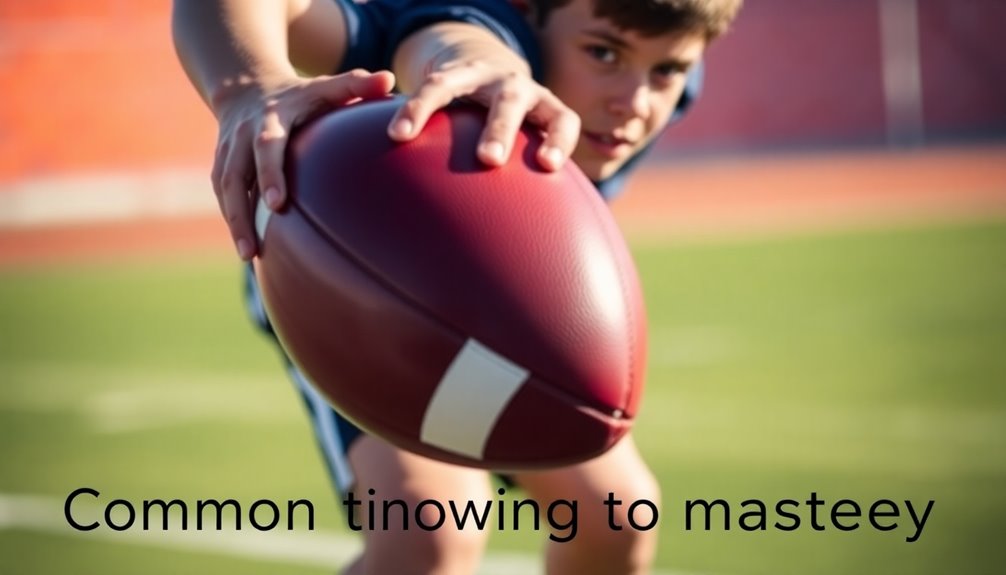
Recognizing common throwing mistakes is vital for improving your football game. If you want to throw the football with confidence and precision, you need to be aware of these pitfalls that can hinder your performance:
- Incorrect grip: Holding the ball too tightly or loosely affects your spin, accuracy, and distance.
- Poor stance: Feet too close together can decrease your balance and power transfer during throws.
- Over-rotation of shoulders: This can disrupt your release timing and cause inconsistent throws, affecting accuracy considerably.
- Inconsistent release timing: A smooth motion from windup to follow-through is critical; otherwise, you risk wobbling passes.
- Neglecting follow-through: A proper finish guarantees your energy is directed toward the target, improving accuracy.
Role of Equipment
While it might seem secondary, the role of equipment in throwing a football can't be overstated. The right football gloves are essential for enhancing your grip and control, allowing you to maintain better ball security during throws, especially in challenging weather.
The textured surfaces of gloves improve friction between your hand and the ball, ensuring accurate passes and minimizing the chances of slips.
Choosing the correct football size also greatly impacts your throwing performance. For players aged 14 and older, size 9 is the official size, while younger players will benefit from smaller sizes that suit their hands better.
Think about how Teddy Bridgewater's use of dual gloves illustrates how specific equipment choices can boost grip and performance, particularly in adverse conditions.
Custom football gloves from brands like Relentless Sports offer personalization for ideal fit and functionality. This fosters confidence and enhances your overall performance on the field.
With the right equipment, you'll feel more assured in your throws, knowing you have the grip and control needed to make accurate passes, no matter the circumstances.
Custom Football Gloves
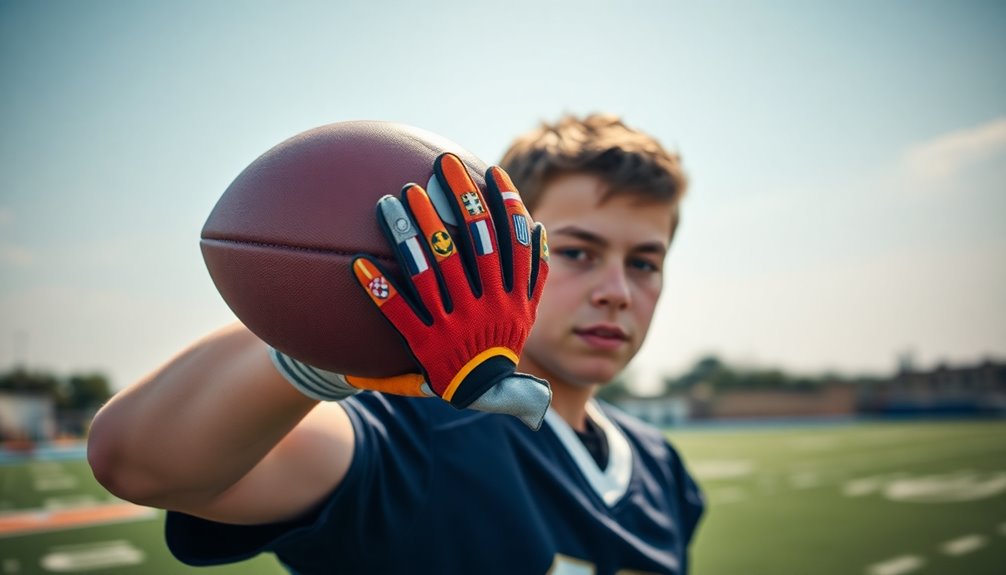
Custom football gloves take your game to the next level by allowing you to tailor your gear to fit your unique style and needs. With custom football gloves from brands like Relentless Sports, you can enhance your performance and express your identity on the field.
These gloves not only improve grip but also foster confidence, leading to better throws and catches.
Here are some benefits of custom football gloves:
- Tailored grip types for ideal control
- Sizes that fit perfectly, ensuring comfort
- Team colors that showcase your loyalty
- Personalization with your name or number
- Textured surfaces for enhanced grip in any weather
Using high-quality materials, these gloves are designed to meet your specific performance needs.
Players like Teddy Bridgewater rely on custom gloves to maintain grip consistency, especially in challenging conditions. The right fit and grip can make a significant difference in your performance, allowing you to focus on your game.
Exercises for Throwing Power
Boosting your throwing power starts with a well-rounded exercise routine that targets key muscle groups.
Begin by focusing on upper body workouts like bench presses, which enhance the strength of your chest, shoulders, and triceps—vital for generating power when you throw a football. Incorporate shoulder exercises, such as overhead presses and lateral raises, to build shoulder stability and strength, contributing to more powerful throws.
Don't overlook your core; performing stability exercises like planks and Russian twists will strengthen your core, facilitating better energy transfer during the throwing motion.
Adding medicine ball throws can mimic the throwing action and improve your dynamic core strength, which is essential for maximizing distance and power.
Finally, turn your attention to your lower body. Power exercises like squats and lunges develop leg strength, providing a solid foundation for generating overall throwing power through effective weight transfer.
By consistently integrating these exercises into your routine, you'll enhance your throwing mechanics and increase your confidence on the field.
Understanding Throwing Angles
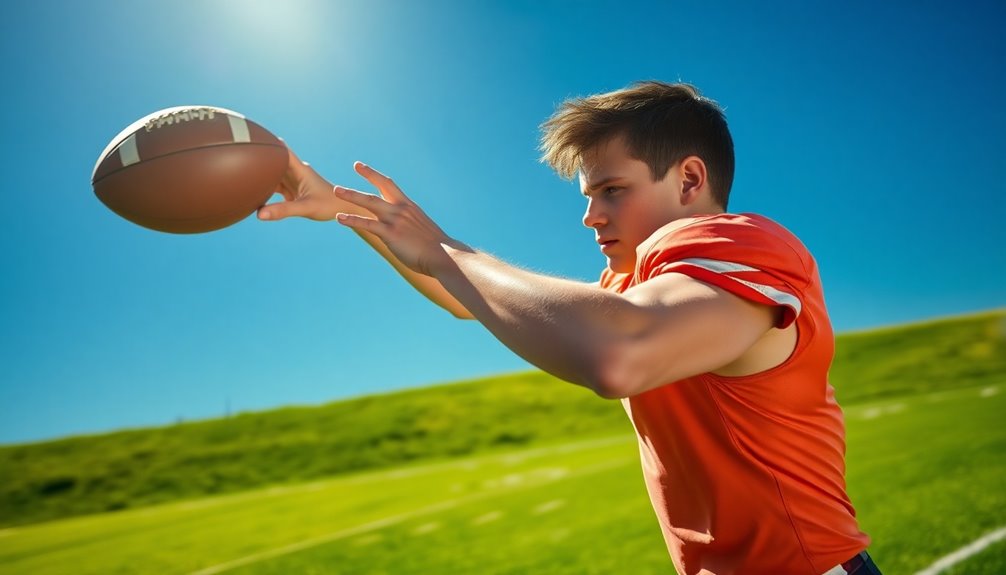
Understanding throwing angles is key to improving your accuracy on the field.
When you throw vertically, you're more likely to hit your target, while horizontal throws can lead to timing issues and greater errors.
Vertical vs. Horizontal Throws
When you're on the field, the angle at which you throw can make all the difference in your accuracy and effectiveness. Understanding the distinction between vertical and horizontal throws is vital.
Vertical throws provide a more forgiving trajectory, allowing you to adjust the angle as needed for better accuracy over distance. In contrast, horizontal throws can complicate your timing and increase your error margin considerably.
Here are some key points to keep in mind when choosing between these throwing angles:
- Vertical throws offer enhanced precision and stability.
- A 1-degree deviation at 10 yards can lead to a 1.7-yard miss.
- Horizontal throws increase the error margin by 89 degrees.
- Over-the-top releases help achieve vertical arm paths.
- Mastering these throwing angles is essential for effective passing strategies.
Angle Deviation Consequences
A slight miscalculation in your throwing angle can lead to unintended consequences on the field. Even a small deviation of just 1 degree can result in a 1.7-yard miss when you're only 10 yards away from your target. This highlights the essential role that throwing angles play in achieving accuracy.
If you're aiming for a horizontal throw, be aware that this can complicate timing and negatively impact your precision.
To optimize your throws, aim for an ideal 90-degree angle at your elbow and armpit. This position enhances your mechanics and guarantees a more accurate pass.
Remember, throwing angles greatly influence the projectile motion of the ball. Gravity affects this motion, and if you don't manage your angles well, inaccuracies can creep in.
Understanding and controlling your throwing angles is critical for effective passing strategies. Small variations in these angles can lead to considerable misses, especially over longer distances.
Adjusting Trajectories for Accuracy
Adjusting your throwing trajectory is essential for hitting your target with precision. By mastering throwing angles, you can greatly improve your accuracy. Here are some key points to keep in mind:
- Vertical Throws: Aim for a vertical trajectory; it allows for more forgiving adjustments and increases your chances of hitting the target.
- Angle Deviation: Remember, even a small angle deviation of just 1 degree at 10 yards can lead to a miss of about 1.7 yards.
- Elbow Position: Maintain a 90-degree angle at your elbow and armpit during throws to maximize both accuracy and power while minimizing injury risks.
- Gravitational Forces: Understand how gravity affects your throws. It can help you find ideal release points, enhancing your overall effectiveness.
- Foot Placement: Position your feet toward the target. Proper foot placement influences the throwing angle and helps maintain balance and stability.
Importance of Grip Technique
Mastering grip technique is essential for anyone looking to throw a football with confidence and accuracy. When you grip the football, secure it with your non-throwing hand at chest level, ensuring you use your fingertips to maintain control. Leave a small gap between your hand and the ball for added stability.
Position your index finger near the back tip of the football and your ring finger on the laces to enhance throw accuracy and control.
Experimenting with different grip styles during practice can help you find what feels most comfortable, ultimately leading to improved throwing performance.
Stance Fundamentals
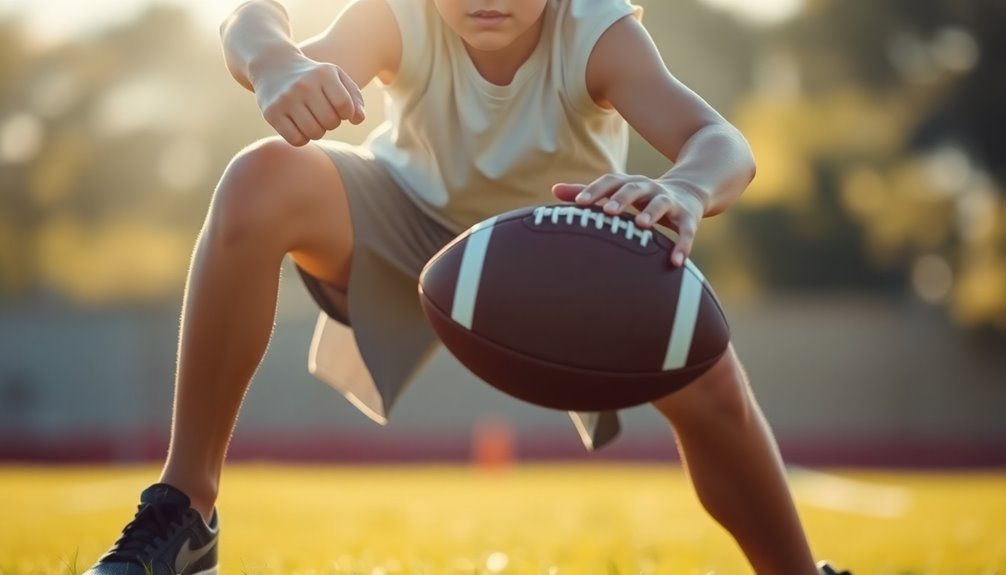
Establishing a solid stance is essential for throwing a football with confidence and power. Your stance fundamentals lay the groundwork for an accurate throw, allowing you to transfer energy effectively throughout the motion.
Here's how to set up your stance for success:
- Feet Position: Position your feet slightly more than shoulder-width apart for stability.
- Knees: Bend your knees slightly to create a bouncy stance for quick movement and power.
- Lead Leg: Confirm your lead leg steps forward toward the target during the throw to drive momentum.
- Shoulder Alignment: Keep your throwing shoulder perpendicular to the target, maintaining proper alignment.
- Balance: Focus on maintaining balance and stability, which influences the power and accuracy of your throw.
Mental Preparation for Confidence
To throw a football with confidence, mental preparation is key.
Use visualization techniques to picture successful throws, and engage in positive self-talk to reinforce your belief in your abilities.
Establishing a pre-game routine can help you stay calm and focused, setting the stage for a confident performance.
Visualization Techniques
While you focus on improving your football skills, incorporating visualization techniques can greatly boost your confidence on the field. By mentally rehearsing successful throws, you can enhance your performance and execution during practice and in games.
Here are some effective visualization strategies to contemplate:
- Picture your grip: Visualize how you hold the football, ensuring your fingers are properly placed.
- Focus on your stance: Imagine yourself in the right position, balanced and ready to throw.
- Follow-through visualization: See yourself completing the throw with perfect follow-through.
- Scenario practice: Envision throwing to a moving target or under pressure to prepare for real-game situations.
- Consistent routine: Make visualization a regular part of your pre-game or practice routine.
Engaging in these visualization techniques not only creates neural patterns that improve muscle memory but also reduces anxiety and boosts self-efficacy.
By practicing these techniques consistently, you'll build the confidence needed to handle various challenges on the field, ensuring your mental preparation aligns with your physical skills.
Embrace the power of visualization, and watch your confidence soar!
Positive Self-Talk
As you prepare for a game or practice, harnessing the power of positive self-talk can transform your mindset and enhance your confidence. By consistently using encouraging phrases, you can greatly boost your belief in your abilities.
Studies show that positive self-talk leads to improved performance, especially in high-pressure situations like throwing a football during a game.
Combine this with visualization techniques, and you'll create a mental image of successful throws, reinforcing the mechanics and desired outcomes. This combination helps you focus on your technique rather than fears of failure.
When you engage in positive self-talk, you mitigate anxiety and build resilience, allowing for a more relaxed mindset.
Setting realistic goals and celebrating your progress using positive language promotes a growth mindset, leading to increased confidence over time.
Remember, the words you say to yourself matter. By embracing positive self-talk before practice or games, you can improve your overall sports performance by up to 20%.
Pre-Game Routine
A solid pre-game routine sets the stage for a confident performance on the field.
By establishing a consistent routine, you'll enhance your familiarity with the game, reduce anxiety, and boost your overall confidence.
Here are key elements to incorporate into your pre-game routine:
- Visualization: Mentally rehearse successful throws to prepare your mind for pressure situations.
- Stretching: Warm up your body to prevent injuries and promote flexibility.
- Light Throwing: Get comfortable with the football and establish a rhythm before the game starts.
- Positive Self-Talk: Use affirmations to reinforce your belief in your abilities and reduce self-doubt.
- Team Bonding: Engage in activities with teammates to foster camaraderie and create a supportive environment.
Conclusion
Just like a skilled archer aims for the bullseye, mastering your football throw requires focus and precision. With the right grip and stance, you'll feel as steady as a tree rooted deep in the ground. Embrace the drills like a craftsman honing their tools, and visualize each throw soaring through the air like a bird in flight. As you build confidence, remember: every throw is a step closer to your target, shaping you into the player you aspire to be.

